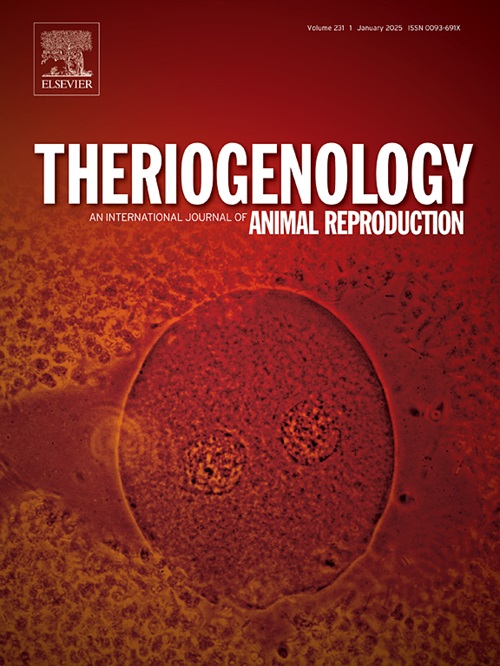Perspectives in milk production in India
IF 2.4
2区 农林科学
Q3 REPRODUCTIVE BIOLOGY
引用次数: 0
Abstract
India is the largest milk producer contributing 25 % to the global production. From a mere 17 million tons (MTs) in 1951, milk production increased to an inconceivable 230 MTs in 2023. Nondescript cows and buffaloes were the main milk animals. Since 1965, nationwide programs for cross breeding native cattle with exotic milk breeds such as Jersey, Holstein Friesian (HF) and Brown Swiss (BS) and upgradation of buffalo breeds along with disease eradication, feed and fodder development and provision of veterinary and extension services were implemented. Now 75 % of the milk in India is produced by the native, exotic and crossbred cows (43 %) and native breeds of buffaloes (32 %). National Dairy Development Board (NDDB) created dairy cooperatives, an Indian innovation to connect rural milk producers to urban and semi-urban consumers. These cooperatives transformed subsistence dairy farming into a profitable rural enterprise and created millions of jobs. Due to the success of the above activities, since 1998 India continues to produce the highest volumes of milk in the world.
It is envisioned to increase (i) milk production to 450 million tons (MTs) (one-third of the global production) (ii) gain a share of 15 % in global milk and milk products exports and (iii) build sustainable green practices to match global standards during the next 25 years.
India is increasingly deploying artificial insemination (AI) with sex sorted-frozen semen, embryo transfer and in vitro production of embryos using sex sorted semen, progeny testing and genomic selection to improve reproduction and productivity among dairy animals. Mitigation of disease burden is undertaken through nationwide vaccination against diseases such as Foot and Mouth, TB, Brucellosis etc. Nutritious fodder crops and feed additives that support higher productivity and reduce enteric methane emissions are promoted. Management and interventional practices such as better nutrition, amelioration of summer stress, oestrus synchronisation etc., are increasingly implemented. Use of internet enabled technology services (IETS) for extension activities, mobile veterinary and animal husbandry services are rapidly becoming commonplace. All these practices portend greater achievements in milk production in the fore-seeable future. Achievements, aspirations, accosts, approaches and appraisal are presented.
印度牛奶生产的前景。
印度是最大的牛奶生产国,占全球产量的 25%。牛奶产量从 1951 年的 1700 万吨增至 2023 年的 230 万吨,令人难以置信。貌不惊人的奶牛和水牛是主要的产奶动物。自 1965 年以来,印度在全国范围内实施了本地牛与外来奶牛品种(如娟珊牛、荷斯坦弗里斯兰牛 (HF) 和棕瑞士牛 (BS))杂交育种和水牛品种改良计划,同时还开展了疾病防治、饲料开发以及兽医和推广服务。现在,印度 75% 的牛奶是由本地奶牛、外来奶牛和杂交奶牛(43%)以及本地水牛品种(32%)生产的。国家奶业发展委员会(NDDB)创建了奶业合作社,这是印度将农村牛奶生产者与城市和半城市消费者联系起来的一项创新。这些合作社将自给自足的奶牛养殖业转变为有利可图的农村企业,并创造了数百万个就业岗位。由于上述活动取得了成功,自 1998 年以来,印度的牛奶产量一直居世界首位。印度计划在未来 25 年内:(i) 将牛奶产量提高到 4.5 亿吨(占全球产量的三分之一);(ii) 在全球牛奶和奶制品出口中占 15%的份额;(iii) 建立可持续的绿色做法,以达到全球标准。印度正越来越多地使用经性别分类的冷冻精液进行人工授精(AI),使用经性别分类的精液进行胚胎移植和胚胎体外生产,进行后代测试和基因组选择,以提高奶牛的繁殖力和生产力。通过在全国范围内接种口蹄疫、结核病、布鲁氏菌病等疾病疫苗,减轻疾病负担。推广有助于提高生产率和减少肠道甲烷排放的营养饲料作物和饲料添加剂。越来越多地采用管理和干预措施,如改善营养、改善夏季应激、发情同步等。利用互联网技术服务(IETS)开展推广活动、移动兽医和畜牧服务正在迅速普及。所有这些做法都预示着在可预见的未来,牛奶生产将取得更大的成就。本文介绍了这方面的成就、愿望、挑战、方法和评价。
本文章由计算机程序翻译,如有差异,请以英文原文为准。
求助全文
约1分钟内获得全文
求助全文
来源期刊

Theriogenology
农林科学-生殖生物学
CiteScore
5.50
自引率
14.30%
发文量
387
审稿时长
72 days
期刊介绍:
Theriogenology provides an international forum for researchers, clinicians, and industry professionals in animal reproductive biology. This acclaimed journal publishes articles on a wide range of topics in reproductive and developmental biology, of domestic mammal, avian, and aquatic species as well as wild species which are the object of veterinary care in research or conservation programs.
 求助内容:
求助内容: 应助结果提醒方式:
应助结果提醒方式:


